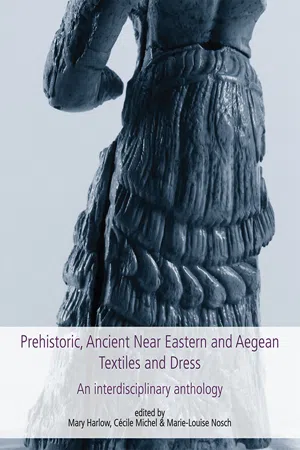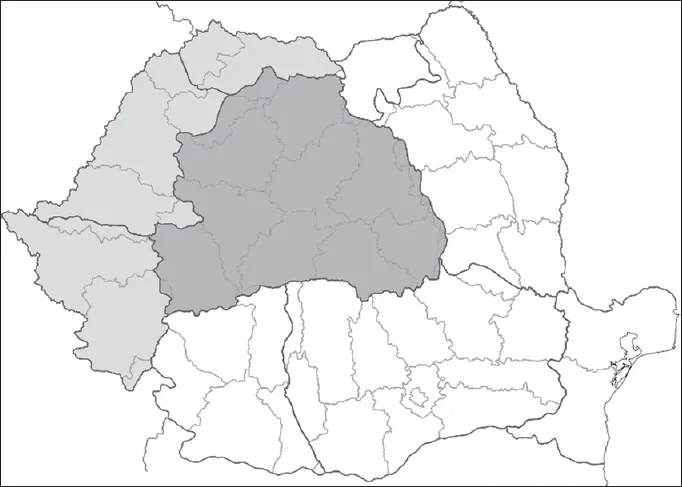
Prehistoric, Ancient Near Eastern & Aegean Textiles and Dress
- 224 pages
- English
- ePUB (mobile friendly)
- Available on iOS & Android
Prehistoric, Ancient Near Eastern & Aegean Textiles and Dress
About this book
Textile and dress production, from raw materials to finished items, has had a significant impact on society from its earliest history. The essays in this volume offer a fresh insight into the emerging interdisciplinary research field of textile and dress studies by discussing archaeological, iconographical and textual evidence within a broad geographical and chronological spectrum. The thirteen chapters explore issues, such as the analysis of textile tools, especially spindle whorls, and textile imprints for reconstructing textile production in contexts as different as Neolithic Transylvania, the Early Bronze Age North Aegean and the Early Iron Age Eastern Mediterranean; the importance of cuneiform clay tablets as a documentary source for both drawing a detailed picture of the administration of a textile industry and for addressing gender issues, such as the construction of masculinity in the Sumerian kingdoms of the 3rd millennium BC; and discussions of royal and priestly costumes and clothing ornaments in the Mesopotamian kingdom of Mari and in Mycenaean culture. Textile terms testify to intensive exchanges between Semitic and Indo-European languages, especially within the terminology of trade goods. The production and consumption of textiles and garments are demonstrated in 2nd millennium Hittite Anatolia; from 1st millennium BC Assyria, a cross-disciplinary approach combines texts, realia and iconography to produce a systematic study of golden dress decorations; and finally, the important discussion of fibres, flax and wool, in written and archaeological sources is evidence for delineating the economy of linen and the strong symbolic value of fibre types in 1st millennium Babylonia and the Southern Levant. The volume is part of a pair together with Greek and Roman Textiles and Dress: An Interdisciplinary Anthology edited by Mary Harlow and Marie-Louise Nosch.
Frequently asked questions
- Essential is ideal for learners and professionals who enjoy exploring a wide range of subjects. Access the Essential Library with 800,000+ trusted titles and best-sellers across business, personal growth, and the humanities. Includes unlimited reading time and Standard Read Aloud voice.
- Complete: Perfect for advanced learners and researchers needing full, unrestricted access. Unlock 1.4M+ books across hundreds of subjects, including academic and specialized titles. The Complete Plan also includes advanced features like Premium Read Aloud and Research Assistant.
Please note we cannot support devices running on iOS 13 and Android 7 or earlier. Learn more about using the app.
Information


Table of contents
- Cover
- Title Page
- Copyright
- Contents
- Acknowledgements
- Contributors
- Chapter 1: Investigating Neolithic and Copper Age Textile Production in Transylvania (Romania). Applied Methods and Results
- Chapter 2: spindle Whorls From Two Prehistoric Settlements on Thassos, North Aegean
- Chapter 3: Textile Texts of the Lagaš II Period
- Chapter 4: In Search of Lost Costumes. On royal attire in Ancient Mesopotamia, with special reference to the Amorite
- Chapter 5: Elements for a Comparative Study of Textile Production and Use in Hittite Anatolia and in Neighbouring Areas
- Chapter 6: Buttons, Pins, Clips and Belts….. ‘Inconspicuous’ Dress Accessories from the Burial Context of the Mycenaean Period (16th–12th cent. BC)
- Chapter 7: Textile Semitic Loanwords in Mycenaean as Wanderwörter
- Chapter 8: Constructing Masculinities through Textile Production in the Ancient Near East
- Chapter 9: Spindles and Distaffs: Late Bronze and Early Iron Age Eastern Mediterranean Use of Solid and Tapered Ivory/Bone Shafts
- Chapter 10: Golden Decorations in Assyrian Textiles: An Interdisciplinary Approach
- Chapter 11: e-ri-ta’s Dress: Contribution to the Study of the Mycenaean Priestesses’ Attire
- Chapter 12: Flax and Linen in the First Millennium Babylonia BC: The Origins, Craft Industry and Uses of a Remarkable Textile
- Chapter 13: Two Special Traditions in Jewish Garments and the Rarity of Mixing Wool and Linen Threads in the Land of Israel